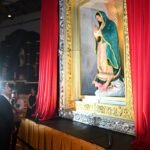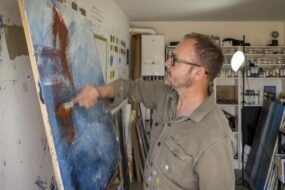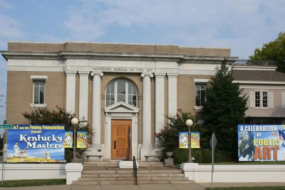

Welcome to One Fine Show, where Observer highlights a recently opened exhibition at a museum not in New York City, a place we know and love that already receives plenty of attention.
Nature painting is a difficult proposition in the modern era. In earlier times, a landscape offered viewers the opportunity to see someplace they’d never been, or a meaty and romantic metaphor for the human condition. These days, our existential questions tend to be expressed through the topics of technology and consumerism. The painter of nature competes with airfare, the lush otherworldly landscapes found within virtual worlds and David Attenborough.
But painter Kim Chong Hak (b. 1937) has managed to capture the attention of the ever-online millennials and Gen Z in South Korea. A new show at the High Museum of Art, “Kim Chong Hak, Painter of Seoraksan,” aims to introduce his work to American audiences, with a first exhibition in this country that takes its name from the mountain in his own that is his frequent subject, the tallest in the Taebaek mountain range. Kim moved to Gangwon Province, which looks onto these peaks, in the late 1970s and in them found a universe that continues to inspire him today.
His subjects may be classic, but Kim uses a modern vernacular. American audiences may be just discovering Kim, but it’s clear that he’s kept up with Western developments in painting. No. 13 (2006) offers a mountain slope with a great deal of personality and technique. Each plane of long oil work could have been made by a different artist, with the sky wisping Impressionistically, and the chunky dark mountain crags looking more like Mark Rothko. What makes the work are the stems of plants that lend it the aforementioned character. This landscape would be desolate without them. Instead, it strives. The farther ones are rendered as defiant scoring while the foreground ones bloom out of the snow in pink and green, which somehow doesn’t feel strange at all.
It’s clear that botany is a subject that he’s studied as much as art history. One of his newer works, Untitled (Landscape Series) (2021), is a lush jungle that demonstrates not only his diversity of painting styles but also his knowledge of species. You can’t invent that many different kinds of flowers, trees and leaves. It’s one of those paintings that sucks you in and surrounds you, a knotty mess of green so thick that it almost makes your eyes cross.
Let’s throw another influence into the mix: Korean craft traditions. His intricate flowers are so detailed and vivid that just one of them could decorate a household object, and indeed, such objects have been an inspiration to him. Shown alongside his art in this show are a selection of design objects from his collection. His flowers do indeed resemble the rainbow ones on one of his bojagi, also known as wrapping cloths. These might be wrapped around a pair of carved ducks presented to a bride and groom for a wedding, and Kim has one of these in his collection as well. One comes away with a sense of Korea as a land where the natural and crafted are inseparable, where the sun sets behind the mountain in the evening, accompanied by visible brushstrokes.
“Kim Chong Hak, Painter of Seoraksan” is on view at the High Museum of Art through November 2, 2025.
More exhibition reviews









